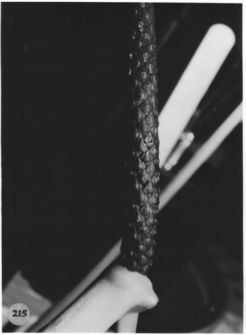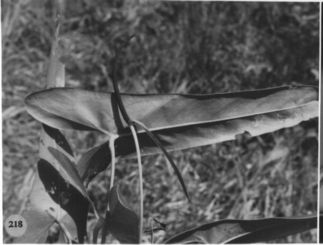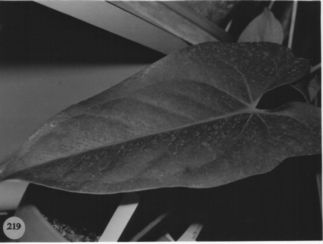






Anthurium verapazense Engl.,
Pflanzenr. IV 23B: 191. 1905. TYPE: Guatemala. Alta Verapaz: Cubilhuitz (Finca Cubilhuitz 15°40'N, 90°25'W) elev. 350 m, H. von. Tuerckheim 7788 (US, holotype).
Usually epiphytic, sometimes terrestrial; stems 4-8 cm long, 5-6 cm diam.; internodes and leaf scars hidden by persisting cataphylls and thick, descending, dark brown roots; cataphylls subcoriaceous, 6-9 cm long, acuminate at apex, sometimes tinged red-violet, subapical apiculum ca. 2 mm long, drying dark brown (B & K Yellow 4/7.5), persisting as reticulate fibers.
LEAVES with petioles erect-spreading, 26-61 cm long, 6-7 mm diam., subterete; geniculum 3-4 cm long, conspicuously sulcate; blades moderately thick, triangular, sometimes ovate-triangular, gradually acuminate at apex, prominently lobed at base, 24-60 cm long, 14-27 cm wide, broadest at base or sometimes at point of petiole attachment; anterior lobe 24-49 cm long, convex to almost straight; posterior lobes 8-17 cm long; sinus hip-pocrcpiform to spathulale to sometimes ovate, usually rounded at apex; both surfaces semiglossy, the lower surface densely punctate; midrib acutely raised above, diminished and sunken from just above the middle to the apex, convexly raised below; basal veins 4-6 pairs, the first free to base, those remaining coalesced 2.5-4 cm, sunken above, raised below; primary lateral veins 7-9 per side, departing midrib at 45°-55° angle, loop-connecting to collective vein, sunken above, prominulous below; lesser veins less conspicuous; collective vein arising from the first basal vein, sunken above, raised below, 4-6 mm from the margin.
INFLORESCENCE arching-pen-dcnt; peduncle 53-90 cm long, 4-6 mm diam.; spathe moderately thin, oblong-lanceolate, green (B & K Yellow-green 7/10), sometimes tinged violet-purple at margins, 8.5-15 cm long, 1-2 cm wide, broadest near base, narrowly acuminate at apex, obtuse at base, inserted at 45° angle on peduncle; spadix violet-purple (B & K Red-purple 2/5), 10-25 cm long, 6.5-8 mm diam. at base, 3-5 mm diam. at apex; flowers rhombic, 3.6-3.8 mm long, 2.3-2.8 mm wide, ihe sides straight parallel to the spiral, gradually sigmoid perpendicular to the spiral; 6-7 flowers visible in the principal spiral, 8-10 flowers visible in the alternate spiral; tcpals matte to semiglossy, obscurely and sparsely punctate, minutely papillate, the lateral tepals ca. 2 mm wide, the inner margin ± concave and turned up against pistil; pistils weakly emergent, violet-purple slightly paler than tepals; stigma slit-like, oblong, ca. 0.6 mm long; stamens emerging in a moderately rapid sequence from the base, the laterals first, followed shortly by alternates, the leading stamens preceding third and fourth by several spirals, briefly exserted on purplish filaments, withdrawing to level of tcpals; anthers yellow, ca. 0.2 mm long, 0.6 mm wide, held in a close, tight circle around pistil; thecae ellipsoid, divaricate; pollen lemon-yellow fading to white.
INFRUCTESCENCE pendent; spadix 15-34 cm long, 1-2.8 cm diam.;
spathe often withered or deciduous;
berries subglobose to obovoid, rounded at apex, developing in the basal
one third to one half, ca. 7 mm long, ca. 6.7 mm diam.; mesocarp juicy,
with numerous whitish raphide cells; seeds 1-2, 3.5-4.2 mm long, 3-3.6
mm wide, 2-2.5 mm thick, broadly ellipsoid to subrounded, flattened, emarginate
at apex, pale purplish-violet with numerous, clear punctations, the surface
sticky, the hypocotyl small. Figs. 215, 218,
and 219.
Anthurium verapazense ranges from Belize to Guatemala along the Atlantic slope in principally moist forest habitats at elevations of 100 to 800 m. It is easily confused with A. lucens, which is more wide ranging, occurring throughout much of Chiapas and northern Guatemala as well as in northern Honduras. The latter is generally found at higher elevations, from 350 to 2,000 m. Anthurium verapazense is in section Belolonchium and is distinguished by its usually long, narrow spathe, much less than half as long as the spadix at anthesis. In addition the inflorescence is usually 1.5 to 3 times longer than the longest petioles. Anthurium lucens differs in having a relatively short spadix with the spathe usually over half as long as the spadix at anthesis, by the relatively shorter inflorescence which is shorter than the leaves or rarely more than 1.5 times longer than the petioles, and by the red, obovoid berries with 2 relatively much larger seeds. Leaf shape in A. verapazense is greatly variable, ranging from deltoid to ovoid to deltoid-hastate. The lobes may be directed downward, sharply outward, or even somewhat inward. Even plants within a single population may show great variability. Neither A. verapazense or A. lucens show correlation with regard to leaf shape although collections from the same area show similar trends in variation. Worthy of mention is a collection of A. verapazense made by Dr. R. Tejada (307) purportedly collected in Maza-tenango, a town on the Pacific slope. I believe it is unlikely that the species ever occurred there and perhaps there was (in 1914) another village called Mazalenango located on the Atlantic slope or perhaps the collection was cultivated in Ma-zatenango. Other species were also collected by Tejada at Mazatenango that are likewise not believed to have ever occurred there. It is possible that additional work will prove that the taxon as constituted here consists of two species. A live collection made by Hans Wiehler near Purulha in Alta Verapaz (Guatemala) and cultivated at Sclby Botanical Gardens produced subglobose, red-orange berries that had 6-9 small seeds. This has been vouchered as Madison 3739. A second Madison collection (6965) from a live plant purportedly also from Purulha bad similar berries with 2 large seeds. These were similar to the berries of other collections studied, namely Jones & Facey 3389 from the department of Ozabal and Boutin 5122 from Belize. The latter is live at the Missouri Botanical Garden. These drastic differences are not easily explained and have not been exhibited in other species of Anthurium. The problem warrants additional investigation.
 |
 |
 |
Map of Mesoamerican specimens with coordinates
Belize : 300 m, 16.34N 88.54W, 1959-60, Hunt 416 (BM).
Belize Cayo:, 2 July 1936, Lundell 6341 (LL).
Belize Cayo: 400 m,, 27 sept. 1980, Sutten et al. 220 (BM).
Belize Cayo: 90-1020 m, 17.00N 88.47W, 22 March 1987, Gerrit Davidse
& Alan E. Brant 33076 (MO).
Belize Stann Creek:, 22 July 1953, Gentle 7981 (LL).
Belize Stann Creek:, 1 May 1953, Gentle 7924 (LL).
Belize Toledo: 15.59N 89.13W, 1 Feb. 1990, Balick et al. 2546 (MO).
Belize Toledo: 100-250 m, 16.33N 88.47W, 2-3, 11 Mar 1987, Gerrit Davidse
& Alan E. Brant 31892 (MO).
Belize Toledo: 300-620 m, 16.34.00N 88.46.30W, 4, 6, 8 March 1987,
Gerrit Davidse & Alan E. Brant 31956 (MO).
Belize Toledo: 300-620 m, 16.34.00N 88.46.30W, 4, 6, 8 March 1987,
Gerrit Davidse & Alan E. Brant 32107 (MO).
Guatemala :, 21 May 1987, Thomas B. Croat 66061 (MO).
Guatemala Alta Verapaz:, , Plowman s.n. (CM, F, NY).
Guatemala Alta Verapaz: 900 ft.,, 5 Aug. 1920, Johnson 896 (UCLA).
Guatemala Izabal: 400-500 m,, 7 May 1966, Jones & Facey 3294 (BM).
Guatemala Izabal: 500-600 m., 15.15-15.35N 89.00-89.25W, 12 May 1966,
Jones & Facey 3389 (LL).
Guatemala Izabal: Mun. Livingston Laguna Escondida, 15.45N 88.48W,
28 July 1988, Tenorio et al. 14930 (MO).
Guatemala Peten:, 15 April 1961, Contreras 2094 (LL).
Guatemala Peten:, 13 July 1959, Lundell 16431 (LL).
Honduras Islas de la Bahía:, , Nelson 10112 (TEFH).